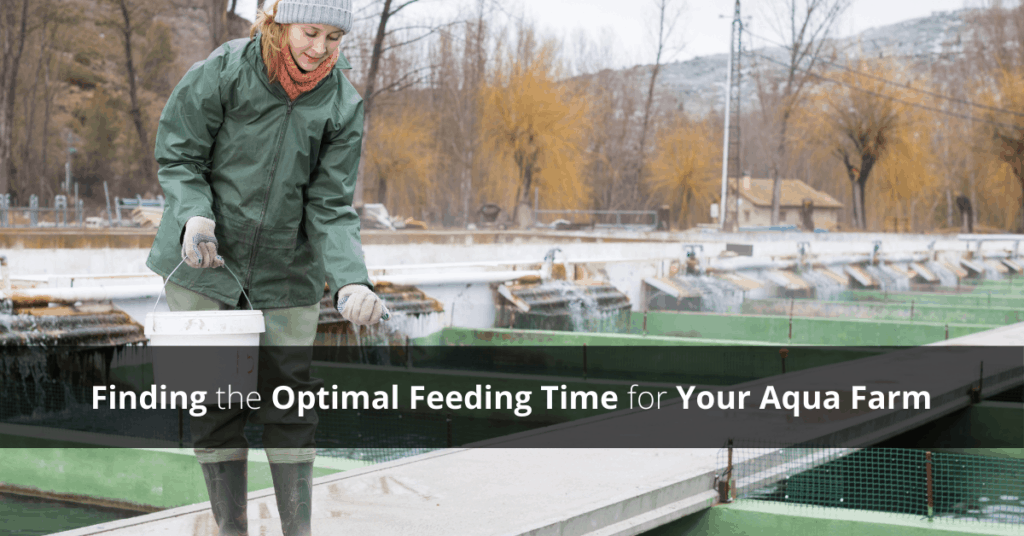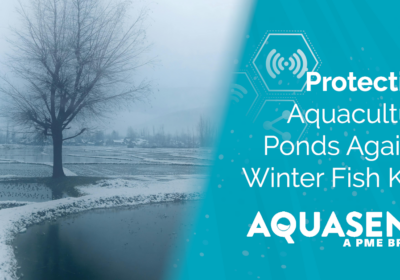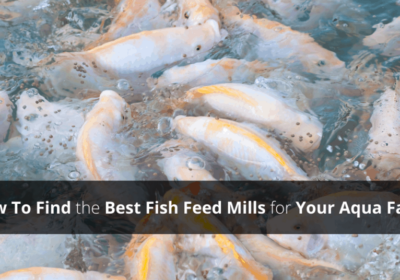Finding the Optimal Feeding Times for Your Aqua Farm

You probably already know that fish diets require specific nutrients, in specific forms, for their bodies to properly digest and utilize. But have you thought about or decided what time of day you are going to feed your fish? Or how many times a day?
If you have a large farm with many ponds spread across long distances, how are you going to make sure all your fish get fed the right amount of food at the right time? How do you know what the best time is for feeding? We will explore the answers to these questions and more in this article.
Feeding Frequency
How many times a day you feed your fish typically depends on three things.
- What type of culture system you are using (i.e., pond system vs. tank system).
- What life stage the fish are at.
- The species of fish you are raising.
Feeding In a Tank System Vs. a Pond System
Tank systems tend to make it easier to feed the fish multiple times a day, since tanks occupy less space than ponds, are less spread out, and you or other employees are likely near the tanks constantly, so it’s easy to drop in small portions of food throughout the day. In a pond system, you have a much greater area to cover when going between ponds than tanks, and they are probably outdoors. For these reasons, it is generally more feasible to only feed each fishpond 1-2 times a day, at scheduled intervals.
Feeding Bases On Fish Life Stage
Juvenile and young fish need to be fed more frequently than adult fish since they are growing at a faster pace. The most common method for feeding juveniles is continuously, using an automatic feed dispenser. As they grow, the feeding frequency will decrease to 3-4 times a day, and once they are ready for “production” the frequency drops to once or twice a day. Frequency can also be determined based on water temperature, weather conditions, and how fish react to the food and/or frequency of feeding.
Feeding Different Fish Species
The optimal feeding frequency is also dependent on the species. For example, sturgeon tend to be fed with on-demand feeders, even through adulthood. This means they essentially feed themselves, since an on-demand feeder requires the fish to do some sort of action that triggers the release of food. On the other hand, young salmon and trout are fed small amounts of feed frequently (young salmonoids can be fed up to 24 times a day), while adult salmon and trout are only fed between 1 and 3 times a day.
Water Quality and Feeding Time
Water quality, especially temperature and dissolved oxygen levels, can positively or negatively affect fish health and feeding habits.
Temperature
Ponds tend to vary in temperature more than tanks, due to the fact that they are exposed to all weather conditions. However, since tanks contain more fish in a smaller area, they are subject to sudden spikes or drops in dissolved oxygen levels and allow less time to respond to an emergency than ponds do.
Metabolism
Fish metabolism is also determined by temperature – their metabolism is faster when they are fed at their optimal temperature. This relationship between metabolism and temperature also means that, depending on location and species, many fish eat less food in the winter than they do in the summer. You can easily find the optimal water temperature range for each fish species on your farm online. Most aqua farmers fine tune the best temperature over time based on experience and observation.
Dissolved Oxygen
Similar to temperature, dissolved oxygen levels affect how much fish eat and their overall health. Fish typically need more oxygen a few hours after feeding to aid in the digestion process (6 or 8 hours later). You want to monitor oxygen levels and add oxygen if needed in that timeframe.
The Dangers of Over- and Under- Feeding
Overfeeding Your Fish
Overfeeding means that there is food left over that went uneaten by the fish. Uneaten fish feed can lower the water quality and will become sludge-like, absorb dissolved oxygen from the water, and add other undesirable chemistry to the pond or tank; it can potentially raise ammonia levels in the water which will cause stress increases in fish. Additionally, it’s expensive to waste fish food.
Underfeeding Your Fish
The main consequence of underfeeding is its negative effects on fish health and growth rate. As you know, the growth rate of your fish translates directly into how profitable they will be. If they don’t eat enough, they will take longer to reach full-size and get to market, which delays the start of a new crop fish. Underfeeding your fish can ultimately decrease your profits.
The Body Weight Formula for Fish Feed
You don’t want to over- or under- feed your fish, but how much should you actually feed them? The rule of thumb is between 1-5% of their body weight. Juvenile fish, since they eat more and more often, will be closer to 5% of their body weight, while adult fish will be closer to 1%.
Benefits of Real-Time Monitoring
The farmer’s job is to create and maintain the best environment for their fish to grow, thrive, and be profitable.” – Tony Vaughn, Aquaculture Advisor & President, Professional Aquaculture Services.
To keep your fish as happy and healthy as possible, monitoring the temperature and dissolved oxygen levels of your ponds in real-time can make a huge difference. The Aquasend Beacon® connects to an online portal that can be accessed from any device and will alert you instantly if the temperature or dissolved oxygen levels drop suddenly. Continual access to this data can also allow you to see trends of when dissolved oxygen drops, and you can then activate your aeration system or set an automatic aerator to turn on and off at those key times of low dissolved oxygen.
Dissolved oxygen levels drop the most during the night, which some respond to by leaving an aerator running all night. Instead, if you know a few key times that dissolved oxygen drops during the night, you can set your aerators to turn on for a specific length of time during those low oxygen points. This will ultimately save you money on electricity and oxygen (depending on the type of aerator you have) since you won’t need to have an aerator running all night.
![]() Unfortunately, it’s almost impossible to buy insurance on your fish in aquaculture so if the fish die due to low dissolved oxygen content you simply lose those profits and there is no insurance pay-out for that. Real-time monitoring equipment like the Aquasend Beacon that alerts you instantly to any issues is as close as you can get to an insurance policy for fish.
Unfortunately, it’s almost impossible to buy insurance on your fish in aquaculture so if the fish die due to low dissolved oxygen content you simply lose those profits and there is no insurance pay-out for that. Real-time monitoring equipment like the Aquasend Beacon that alerts you instantly to any issues is as close as you can get to an insurance policy for fish.
Ready to protect your bottom line and give your farm a breath of fresh air? Contact Aquasend® today to order your Aquasend Beacon®.


